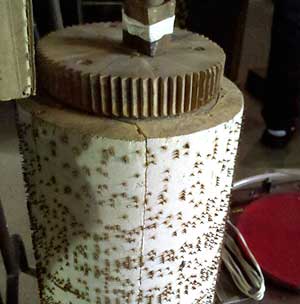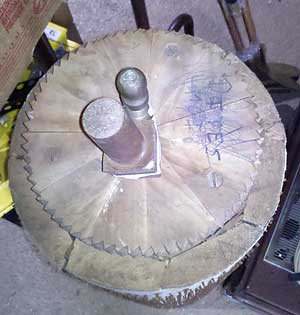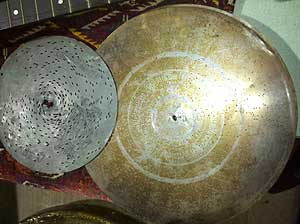“What do you think this is?” I asked, interrupting the two men chatting across from where I stood looking dumbfounded at an item on the floor at the auction house. They stopped their conversation, and one walked over to eye it closer.
“This” was a wide cylinder with rusty metal studs sticking out all around its body in some unrecognizable pattern. On first glance, it looked like some medieval torture mechanism. But then it reminded me of the small slits on old player piano rolls but with pointed ends. It also reminded me of the metal slitted discs that I had seen lying on one of the other auction tables (larger versions of Thorens music box discs).

The cylinder stood about 3 ½ feet to 4 feet tall, and it was heavy. It had been placed among some dusty Victrola cabinets, records, papers and discs waiting to be auctioned. All apparently had been part of someone’s collection, along with some piano rolls in their original boxes.
“Your guess is as good as mine,” the man said, but then he started guessing and joking. It looked like an old acupuncture roller, he said. You’d be aching more after that treatment than before, I replied.
Then he suggested other uses for it: Put a glass top on it and turn it into a table. Add a light fixture and shade, and make it into a lamp. Then he started to go punchy: Put it over your door and when someone breaks in, it’ll fall on their head.

He was right – my guess was as good as his. Because of where it had been placed on the auction floor, I assumed that it had to do with piano rolls, music, Victrolas and the like. Maybe it was used to punch holes in the paper.
According to the website jazzwax.com, piano rolls offered people their first sound of recorded music. The site related how the music was recorded on paper as musicians played. The more I read about how they were made, though, the more I was convinced that this was not an instrument for making them.

I’d love to know what this contraption was used for. Do you know?

It looks like a VERY large music box cylinder – here’s a video by UIUC Prof. Bill Hammack about the inner mechanics of music boxes (5:16 has a nice, clear diagram, and 5:26 shows a large music box, but the one in your photos seems like it might be larger!): https://www.youtube.com/watch?v=COty6_oDEkk